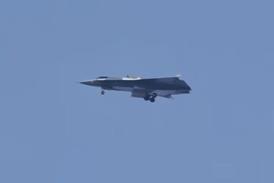Repairing Boeing's global supply chain model remains the key concern for 787 programme managers under the latest revised schedule that delays first delivery by 15 months beyond the original date and slows the production ramp to a crawl.
"Where do I think the inherent risk is?" asked Pat Shanahan, Boeing's 787 vice-president and general manager. "It's more in the capabilities of the supply chain to do what we want. That's the untested part of this production model, and, as they learn and grow and improve, the system will produce more aircraft."
 |
|---|
© Boeing |
The supply chain - including six producers in three countries assigned to develop and assemble major aircraft sections - has improved since Boeing came to grips last August with a nearly system-wide breakdown, but the rate of progress is not nearly fast enough, Shanahan says.
The supply chain's slower path to maturity has forced Boeing to redesign the outlines of the production schedule, although details remain either undisclosed or undetermined.
Boeing has revealed the first 25 aircraft will be delivered during the last five months of 2009, or just less than one-fifth of the amount in the original plan.
The production rate also is now slowed to fewer than 10 aircraft a month until 2012. That level of output would be the greatest ever achieved for widebody aircraft, matched only by Airbus's expected A350 throughput. Even so, Boeing originally planned to reach that level by 2010 and perhaps grow to as many as 16 aircraft per month two years later.
The new production ramp is based on "more traditional ramp rates of other twin-aisle airplanes, and now we're going to take some more time to think of ways we could make it better," says Boeing Commercial Airplanes (BCA) president and chief executive Scott Carson. That will depend greatly on Boeing's ability to make its far-flung assembly system as cohesive as its established manufacturing base in Everett, Washington.
The first major step appeared on 28 March with Boeing's announced buy-out of Vought's share of Charleston, South Carolina-based Global Aeronautica, a joint venture with Italy's Alenia Aeronautica.
After replacing former 787 vice-president Mike Bair in October, Shanahan is continuing to take a firmer, hands-on grip of his major suppliers, in particular Vought, Alenia and Japan's major structural providers. These days Boeing's management team confirms in person that the suppliers can make good on their promises. "We do it on site, eyeball to eyeball, and verify that things that are required to perform are in place," says Shanahan, who is credited with turn-around jobs at Boeing's missile defence and military rotorcraft divisions.
Shanahan and Carson recently returned from visiting Boeing's major suppliers in Japan, which include Kawasaki, Mitsubishi and Fuji. The executives discussed "how we improve the communications between the two teams and how we review in a more timely way issues that are affecting their ability to be supported in the way we need to support them," Carson says.
Boeing's supply system, however, remains in some degree of flux in the wake of the programme's third major delay for first delivery to launch customer All Nippon Airways.
In a conference call with analysts and reporters on 9 April, Carson stopped short of making a firm pledge to keep the current supplier network intact.
"We have an arrangement that we have established for the programme [and] we're working through with the individual suppliers to address the specific circumstances they found that would affect their relationship on the programme, whether it's [787]-8 or -9," he says.
The revised schedule means the first flight date will shift from June to at October at the earliest. Boeing lists the new first delivery date as the third quarter of 2009. Shanahan says the new schedule allows more than four months to deliver 25 aircraft, indicating that the actual first delivery date will occur in August 2009.
That gives Boeing a 10-month schedule to complete flight tests for FAA certification, which adds a three-month buffer to the original plan.
Boeing also is building a new, two-month buffer into the schedule between the new power-on date in June and the first flight date in October, reflecting a more conservative planning approach.
"We may run into issues that may require more time that originally planned," says Shanahan. However, he adds, "If we don't need the additional time we won't use it."
Source: Flight International























